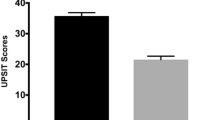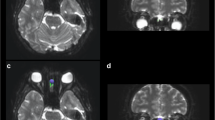Abstract
Evidence from imaging, clinical studies, and pathology suggests that Parkinson’s disease is preceded by a prodromal stage that predates clinical diagnosis by several years but there is no established method for detecting this stage. Olfactory impairment, which is common in Parkinson’s disease and often predates clinical diagnosis, may be a useful biomarker for early Parkinson’s. Evidence is emerging that diffusion imaging parameters might be altered in olfactory tract and substantia nigra in the early stages of clinical Parkinson’s disease, possibly reflecting pathological changes. However, no study has examined olfaction and diffusion imaging in olfactory tract and substantia nigra in the same group of patients. The present study compared newly diagnosed Parkinson’s disease patients with a matched control group using both olfactory testing and diffusion tensor imaging of the substantia nigra and anterior olfactory structures. Fourteen patients with stage 1–2 Hoehn & Yahr Parkinson’s disease were matched to a control group by age and sex. All subjects then completed the University of Pennsylvania Smell Identification Test, as well as a series of MRI scans designed to examine diffusion characteristics of the olfactory tract and the substantia nigra. Olfactory testing revealed significant impairment in the patient group. Diffusion tensor imaging revealed significant group differences in both the substantia nigra and anterior olfactory region, with fractional anisotropy of the olfactory region clearly distinguishing the Parkinson’s subjects from controls. This study suggests that there may be value in combining behavioral (olfaction) and MRI testing to identify early Parkinson’s disease. Since loss of olfaction often precedes the motor symptoms in Parkinson’s disease, the important question raised is “will the combination of olfactory testing and MRI (DTI) testing identify pre-motor Parkinson’s disease?”



Similar content being viewed by others
References
Fearnley JM, Lees AJ (1991) Ageing and Parkinson’s disease: substantia nigra regional selectivity. Brain 114(Pt 5):2283–2301
Morrish PK, Rakshi JS, Bailey DL, Sawle GV, Brooks DJ (1998) Measuring the rate of progression and estimating the preclinical period of Parkinson’s disease with [18F] dopa PET. J Neurol Neurosurg Psychiatry 64:314–319
Marek K, Innis R, van Dyck C, Fussell B, Early M, Eberly S, Oakes D, Seibyl J (2001) [123I]beta-CIT SPECT imaging assessment of the rate of Parkinson’s disease progression. Neurology 57:2089–2094
Braak H, Bohl JR, Muller CM, Rub U, de Vos RA, Del Tredici K (2006) Stanley Fahn lecture 2005: the staging procedure for the inclusion body pathology associated with sporadic Parkinson’s disease reconsidered. Mov Disord 21:2042–2051
Doty RL, Bromley SM, Stern MB (1995) Olfactory testing as an aid in the diagnosis of Parkinson’s disease: development of optimal discrimination criteria. Neurodegeneration 4:93–97
Tissingh G, Berendse HW, Bergmans P, DeWaard R, Drukarch B, Stoof JC, Wolters EC (2001) Loss of olfaction in de novo and treated Parkinson’s disease: possible implications for early diagnosis. Mov Disord 16:41–46
Doty RL (2009) The olfactory system and its disorders. Semin Neurol 29:74–81
Haehner A, Boesveldt S, Berendse HW, Mackay-Sim A, Fleischmann J, Silburn PA, Johnston AN, Mellick GD, Herting B, Reichmann H, Hummel T (2009) Prevalence of smell loss in Parkinson’s disease—a multicenter study. Parkinsonism Relat Disord 15:490–494
Hawkes CH (2008) The prodromal phase of sporadic Parkinson’s disease: does it exist and if so how long is it? Mov Disord 23:1799–1807
Hawkes CH (2003) Olfaction in neurodegenerative disorders. Mov Disord 18:364–372
Berendse HW, Booij J, Francot CM, Bergmans PL, Hijman R, Stoof JC, Wolters EC (2001) Subclinical dopaminergic dysfunction in asymptomatic Parkinson’s disease patients’ relatives with a decreased sense of smell. Ann Neurol 50:34–41
Ponsen MM, Stoffers D, Booij J, van Eck-Smit BL, Wolters E, Berendse HW (2004) Idiopathic hyposmia as a preclinical sign of Parkinson’s disease. Ann Neurol 56:173–181
Ponsen MM, Stoffers D, Wolters E, Booij J, Berendse HW (2010) Olfactory testing combined with dopamine transporter imaging as a method to detect prodromal Parkinson’s disease. J Neurol Neurosurg Psychiatry 81(4):396–399
Scherfler C, Schocke MF, Seppi K, Esterhammer R, Brenneis C, Jaschke W, Wenning GK, Poewe W (2006) Voxel-wise analysis of diffusion weighted imaging reveals disruption of the olfactory tract in Parkinson’s disease. Brain 129:538–542
Chan L, Rumpel H, Yap K, Lee E, Loo H-V, Ho G-L, Fook-Chong S, Yuen Y, Tan E-K (2007) Case control study of diffusion tensor imaging in Parkinson’s disease. J Neurol Neurosurg Psychiatry 78:1383–1386
Menke RA, Scholz J, Miller KL, Deoni S, Jbabdi S, Matthews PM, Zarei M (2009) MRI characteristics of the substantia nigra in Parkinson’s disease: a combined quantitative T1 and DTI study. Neuroimage 47:435–441
Vaillancourt DE, Spraker MB, Prodoehl J, Abraham I, Corcos DM, Zhou XJ, Comella CL, Little DM (2009) High-resolution diffusion tensor imaging in the substantia nigra of de novo Parkinson disease. Neurology 72:1378–1384
Skorpil M, Rolheiser T, Robertson H, Sundin A, Svenningsson P (2010) Diffusion tensor fiber tractography of the olfactory track. Magn Reson Imaging. doi:10.1016/j.mri.2010.07.004
Hughes AJ, Daniel SE, Kilford L, Lees AJ (1992) Accuracy of clinical diagnosis of idiopathic Parkinson’s disease: a clinicopathological study of 100 cases. J Neurol Neurosurg Psychiatry 55:181–184
Doty RL, Shaman P, Dann M (1984) Development of the University of Pennsylvania Smell Identification Test: a standardized microencapsulated test of olfactory function. Physiol Behav 32(3):489–502
Doty RL, McKeown DA, Lee WW, Shaman P (1995) A study of the test-retest reliability of ten olfactory tests. Chem Senses 20:645–656
Smith SM, Jenkinson M, Johansen-Berg H, Rueckert D, Nichols TE, Mackay CE, Watkins KE, Ciccarelli O, Cader MZ, Matthews PM, Behrens TEJ (2006) Tract-based spatial statistics: voxelwise analysis of multi-subject diffusion data. NeuroImage 31:1487–1505
Andersson JLR, Jenkinson M, Smith S Non-linear optimization. In: FMRIB technical report TR07JA1 www.fmrib.ox.ac.uk/analysis/techrep. Accessed 18 May 18 2010
Andersson JLR, Jenkinson M, Smith S Non-linear registration, aka Spatial normalization. In: FMRIB technical report TR07JA2 www.fmrib.ox.ac.uk/analysis/techrep. Accessed 18 May 2010
Hoehn MM, Yahr MD (1967) Parkinsonism: onset, progression and mortality. Neurology 17:427–442
Acknowledgments
TR is grateful to the Faculty of Medicine at Dalhousie University (RAL) for the postdoctoral support grant. We are grateful to Carl Helmick and the staff of the MRI suite, IWK Health Sciences Centre for assistance. Supported by the Dalhousie University Department of Psychiatry Research Fund, Canadian Institutes of Health Research and the Parkinson Society Canada.
Author information
Authors and Affiliations
Corresponding author
Rights and permissions
About this article
Cite this article
Rolheiser, T.M., Fulton, H.G., Good, K.P. et al. Diffusion tensor imaging and olfactory identification testing in early-stage Parkinson's disease. J Neurol 258, 1254–1260 (2011). https://doi.org/10.1007/s00415-011-5915-2
Received:
Revised:
Accepted:
Published:
Issue Date:
DOI: https://doi.org/10.1007/s00415-011-5915-2




